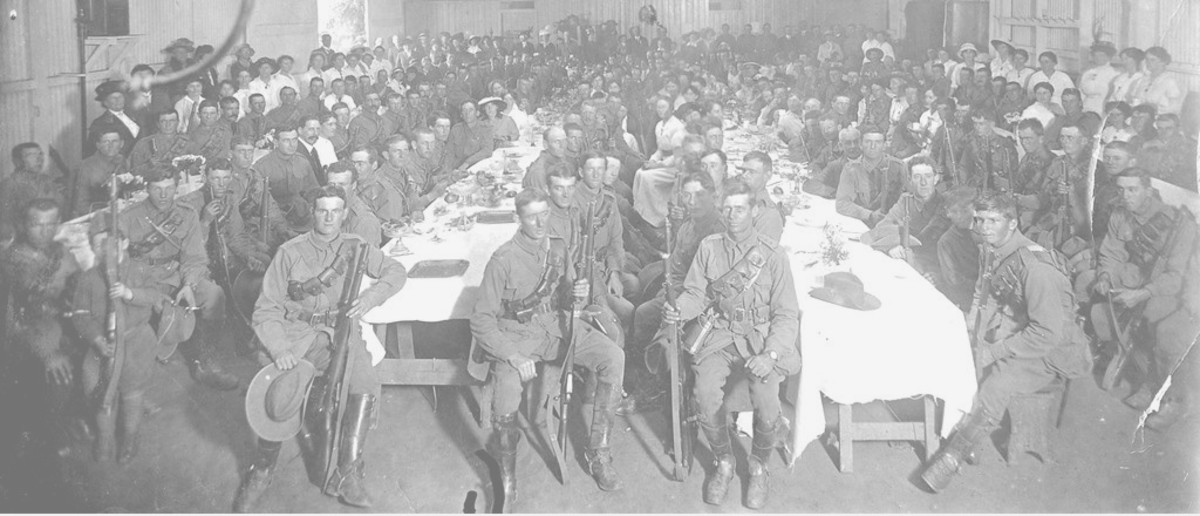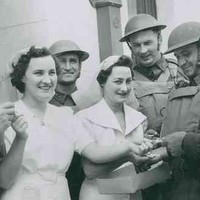Place
ContributeThe Cheer-Up Society was a uniquely South Australian organisation established in 1914 by Adelaide businesswoman Alexandrine (Alexandra) Seager and William Sowden of the Register newspaper to provide for the needs of soldiers on the move during the First World War.
Establishment
Staffed largely by women volunteers, the society began offering refreshment and recreation in a large tent north of the Adelaide Railway Station early in 1915. The tent was replaced by a hut, built through fundraising and with material and labour donated by local businesses and tradespeople. The Cheer-Up Hut opened on 4 November 1915.
The opening of the Cheer-Up Hut was accompanied by a ‘Button Day’ to raise funds for the society and its work. The sale of especially designed buttons or badges began at 8am with ‘an army of girls’ selling them in the main streets of Adelaide. The women volunteers were organised into groups representing those ‘fighting at the front’. The 3rd and 9th Light Horse, the 10th, 12th, 16th and 27th Battalions, and the Army Medical Corps were all represented. Some wounded returned soldiers also assisted.
Operation
The first Cheer-Up Society membership badge was the subject of a competition run in 1914. Nelson Wood of Adelaide won with his design for a bronze medallion. A new badge replaced this one later in the war. Badge days and fairs became regular fundraising events for the society.
At the Cheer-Up Hut, soldiers could eat a meal and relax in a place deemed morally safer than hotels. Free entertainment was provided and facilities included a rest room, billiard room, dining hall and lounge areas. Special celebrations were organised at times such as Christmas. By the end of 1915 volunteers were serving about 10 000 meals per month. In four years the society catered for 200 000 servicemen.
In July 1918 the hut’s amenities were increased with the opening of a State War Council Soldiers’ Hostel. Located west of the City Baths and close to the hut, it provided much needed accommodation for 50 men, a lunch room, and hot and cold baths.
The hut closed on 24 December 1919 after the bulk of the servicemen had returned following the end of the war. However, it reopened as required to cater for later arrivals and provided a venue for returned soldier activities and associations.
Cheer-Up Volunteers
The society imposed strict discipline on its volunteers. Only women of ‘good character’ could join. The volunteers cooked, served meals, distributed foodstuffs and clothes, and organised entertainments, formal farewells and ‘Welcome Home’ gatherings for soldiers.
Volunteers wore white dresses, with an apron and headdress, similar to a nurse’s uniform. Later in the war they pinned embroidered service emblems onto their aprons. Each stripe below the emblem represented a year of voluntary service in the society. Volunteers also wore an embroidered cloth badge on their headdress.
In addition to providing services at the Cheer-Up Hut, the society instigated a Violet Day appeal, with the first being held on 2 July 1915. Small posies of ‘the humble and beautiful violet’ were sold to raise funds for the establishment of a permanent club for returned soldiers. Violet Day became a local remembrance day for Australian soldiers who died during the First World War.
Second World War
The Cheer-Up Hut was revived on a much larger scale in 1939 for the Second World War. The facilities built during the First World War were improved and a large accommodation hostel erected at the rear. The Schools' Patriotic Fund (SPF) Hostel offered accommodation from 1941 for servicemen on leave. The large number of servicemen coming through Adelaide in 1942–43 led to a Cheer-Up Hut No. 2 being established in the Palais Royal dance venue on North Terrace. The original hut was renamed Cheer-Up Hut No. 1.
Post War
After the Second World War Hut No. 1 and the SPF Hostel were sold to the state government which converted them to the Elder Park Migrant Hostel, providing initial accommodation for newly arrived migrants from Europe. The Cheer-Up Society disbanded in 1964 and its funds and assets were distributed to welfare and service groups. A Cheer-Up Association succeeded the society but the gatherings of these former members of the society fell away in 1970 when the hostel was demolished for the construction of the Adelaide Festival Centre.
Media
Add mediaBuildings
Images

Image courtesy of the State Library of South Australia, SLSA: B2365, Public Domain

Image courtesy of the State Library of South Australia, SLSA: PRG 1162/4/13, Public Domain.

Image courtesy of the State Library of South Australia, SLSA: PRG 1162/4/1, Public Domain.
First World War and inter war years
Images

Image courtesy of the State Library of South Australia SLSA: B 5504, Public Domain.

Image courtesy of the State Library of South Australia SLSA: B 5508, Public Domain.

Image courtesy of the State Library of South Australia, SRG 488/18/4, Public Domain

Image courtesy of the State Library of South Australia SLSA: PRG 280/1/17/122, Public Domain.

Image courtesy of the State Library of South Australia, SLSA: PRG 280/1/18/31, Public Domain.

Image courtesy of the State Library of South Australia SLSA: PRG 280/1/18/40, Public Domain.

Image courtesy of the State Library of South Australia SLSA: PRG 280/1/29/106, Public Domain.

Image courtesy of the State Library of South Australia, SLSA: PRG 280/1/9/215, Public Domain

Image courtesy of the State Library of South Australia SLSA: PRG: 280/1/9/223, Public Domain.

Image courtesy of the State Library of South Australia SLSA: PRG 280/1/9/29, Public Domain.

Image courtesy of the State Library of South Australia, SLSA: B 26348, Public Domain.
Related objects
Second World War
Images

Image courtesy of the State Library of South Australia SLSA: B 17540/87, Public Domain.

Image courtesy of the State Library of South Australia SLSA: B 60093, Public Domain.

Image courtesy of the State Library of South Australia SLSA: B 62156, Public Domain.



Comments
CommentAdd new comment
We don't appear to have anything on file specifically about Nancy, but you might like to take a look through the State Library of South Australia's collections Brook. They have quite a lot on the Cheer Up Hut and workers, and you may be able to find a record of Nancy there. You can search the catalogue online at - https://www.catalog.slsa.sa.gov.au/
My mother, Nancy Winifred Angove worked at the Cheer Up Hut in WWII although I'm not sure i n what capacity given she was only 12 when the war started and 18 when it concluded. She now lives in Melbourne where her entire immediate family all live, and she is now 94 years of age.
Does anyone recall her ?
Absolutely Kym,
"At the Cheer-Up Hut, soldiers could eat a meal and relax in a place deemed morally safer than hotels. Free entertainment was provided and facilities included a rest room, billiard room, dining hall and lounge areas. Special celebrations were organised at times such as Christmas." [under 'Operation' above].
You might find more on Trove if you search the Newspapers and Gazettes category for your Grandfather's name - https://trove.nla.gov.au/
When doing a profile on my Grandfather Glen Truscott I was told he played the violin at The Cheer Up Hut during WW2. Did they do performances for the troops?
There was certainly some interesting work going on in the country branches Helen. If you haven't already discovered it the book 'Cheer up: A story of war work' by Frederick J Mills (Adelaide: Cheer-up Society, Board of Management, 1920) is an interesting read on the WWI activities.
Lovely to here of your mothers i have been reading up on the Cheer up girls. My Grandmother.Ruby Scott later Francis work with cheerup girls in W.W.1. Not sure if Murray Bridge she came from Freeling married later at murray bridge. My mother Mary Francis later Rowe. also a Cheerup girl W.W.2. Adelaide. IT has been great to read the story of the Burra and Adelaide group W.W.1 from the Library.
What a fantastic family history Cynthia, thank you for sharing it here.
My Grandmother who I never met Ada Lillian Ivett was involved with The Cheer up Hut as well as many other clubs like District Trained Nurses, the Housewives Association Comforts Fund unit and was president at one time, her name is on the Worker's Memorial Statue in Port Adelaide .
It sounds quite possible Deena, what a fascinating life your grandmother must have led!
Hi Robyn, my Grandmother was a volunteer at the Cheer Up Hut for a number of years, and also entertained there. Her name was Decima Harvey, she was a well known radio vocalist, did lots of broadcasting and appeared in camp concerts organised by the ABC. I wonder if they knew each other?
What a romantic story Robyn. I'd love to hear that recording one day.
My mother was the lead singer in a band at the Cheer Up Hut in 1944. My father (a newly arrived pilot in Adelaide) went in there one night with his fellow pilots and saw her singing. He said to them that the singer would one day be his wife. My Mother died last year after nearly seventy years of marriage to that pilot. I still have a recording of the song she sang. This place was very special to them and to me as part of our family history.
Thanks for sharing your thoughts Kay, Alexandrine Seager certainly sounds like an amazing woman, I would love to meet her!
The wonderful thing about history is learning about how great people in all times and places have seen a human need and done something about it. Very often it has been women and their contribution has been largely unacknowledged. Alexandra Seager is clearly one of these wonderful women and it's been a privilege to learn something of her achievements and the other women who supported her initiative.